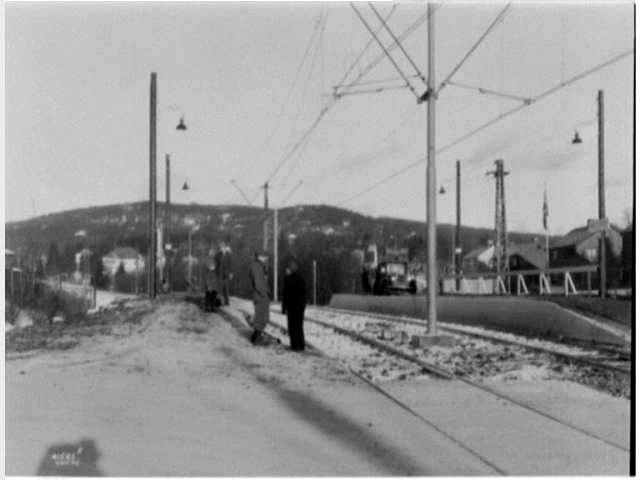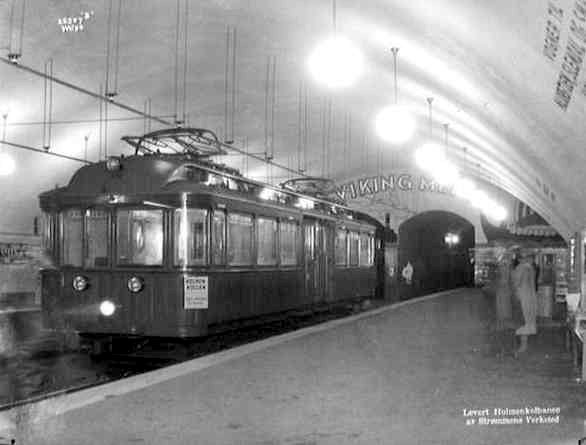|
Holmen, Oslo
Holmen is a neighbourhood in Oslo and forms part of the district of Vestre Aker. It is situated between Hovseter in the west and Slemdal in the east, Holmenkollen in the north and Makrellbekken in the south. The name is derived from the Holmen farms. ''Vestre Holmen'' is located west of ''Holmenkollveien'', a secondary road in Norway's road network, extends along ''Arnebråtveien'' approximately in the north–south direction and west towards the Røa Line of Oslo Metro. Here are the housing estates of Holmenhaugen and Holmengrenda with terraced houses and detached houses. The building company Holmenbygg AS has erected 13 four-story apartment blocks in ''Lybekkveien'', ''Stasjonsveien'', and ''Holmengrenda'' streets. The housing estate of the Royal Norwegian Air Force, also called ''Snippen'', is located further up ''Stasjonsveien'', along ''Landingsveien'', in ''Luftfartsveien'', ''Flyveien'', and ''Pilotveien''. It was designed by the architect Erling Viksjø and was built fro ... [...More Info...] [...Related Items...] OR: [Wikipedia] [Google] [Baidu] |
Counties Of Norway
Norway is divided into 11 administrative regions, called counties (singular no, fylke, plural nb, fylker; nn, fylke from Old Norse: ''fylki'' from the word "folk", sme, fylka, sma, fylhke, smj, fylkka, fkv, fylkki) which until 1918 were known as '' amter''. The counties form the first-level administrative divisions of Norway and are further subdivided into 356 municipalities (''kommune'', pl. ''kommuner'' / ''kommunar''). The island territories of Svalbard and Jan Mayen are outside the county division and ruled directly at the national level. The capital Oslo is both a county and a municipality. In 2017, the Solberg government decided to abolish some of the counties and to merge them with other counties to form larger ones, reducing the number of counties from 19 to 11, which was implemented on 1 January 2020. This sparked popular opposition, with some calling for the reform to be reversed. The Storting voted to partly undo the reform on 14 June 2022, w ... [...More Info...] [...Related Items...] OR: [Wikipedia] [Google] [Baidu] |
Røa Line
The Røa Line ( no, Røabanen) is a rapid transit line of the Oslo Metro, Norway, which runs from Majorstuen in Oslo to Østerås in Bærum. It serves neighborhoods such as Smestad, Hovseter, Huseby and Røa in northwestern Oslo, and Grini, Øvrevoll and Østerås in northeastern Bærum. The line is served by Line 2 of the metro, which connects to the city center via the Common Tunnel and onwards along the Furuset Line. The lowest part of the Røa Line, consisting of two stations, is shared with the Kolsås Line, and thus also served by Line 2 of the metro. The Røa Line is owned by Kollektivtransportproduksjon, and operated by Oslo T-banedrift on contract with the public transport agency Ruter. The first part of the line, originally a light rail, was from Majorstuen to Smestad, and opened in 1912. It was built as a cooperation between the Municipality of Aker and the company Holmenkolbanen, and connected to the Holmenkoll Line's terminus. In 1928, the line received a conn ... [...More Info...] [...Related Items...] OR: [Wikipedia] [Google] [Baidu] |
Holmen (station)
Holmen is a station on the Røa Line (line 2) of the Oslo T-bane system. It is located between Makrellbekken and Hovseter and serves the neighbourhood of Holmen. The station is 6.1 km from Stortinget. Holmen was opened on 24 January 1935 when the line was completed to Røa. The station is at an altitude of 119.4 metres above sea level. The station is located in a mainly residential area. The Oslo subway system has fought a battle against graffiti Graffiti (plural; singular ''graffiti'' or ''graffito'', the latter rarely used except in archeology) is art that is written, painted or drawn on a wall or other surface, usually without permission and within public view. Graffiti ranges from s ..., and one of the incidents turned violent on 2 February 2007, when a subway driver was beaten by a vandal. [...More Info...] [...Related Items...] OR: [Wikipedia] [Google] [Baidu] |
IF Ready
Idrettsforeningen Ready is a sports club in Vestre Aker, Oslo, Norway. The club was established on June 14, 1907 by Aage Blom Lorentzen. The football club play their home games at Gressbanen in Oslo. Gressbanen was the arena for the Norway national team before Ullevaal was constructed in 1928. Former Norwegian international Dan Eggen has played for Ready. Ready's elite bandy team started playing in the Norwegian Bandy Premier League 2004–05, where they remain. The club has 14 Norwegian championships; the last one in 2015 after having won their 13th championship in 1927. He was captain of the national bandy team and twice man of the year in Norwegian bandy, Christian Waaler, plays for the team. He is making an attempt to bring bandy to the Philippines. The club's female bandy team has five international players for Norway. Ski jumper Jon Aaraas Jon Aaraas (born 10 March 1986) is a retired Norwegian ski jumper. He debuted in the World Cup in 2005 in Pragelato, wher ... [...More Info...] [...Related Items...] OR: [Wikipedia] [Google] [Baidu] |
Gressbanen
Gressbanen or Vestre Holmen is a stadium located at Holmen in Oslo, Norway. During summer it has artificial turf and is used for association football, while during winter it has artificial ice and fields bandy. The complex also contains a smaller training field with gravel during summer and natural ice during winter. Gressbanen is the home venue of IF Ready, whose bandy team plays in the Norwegian Bandy Premier League and who fields 35 recreational football teams. The stadium was built as a response to the need for a grass pitch for the Norway national football team, as well as to serve as a home to Ready and Mercantile SFK. It opened on 1 September 1918 as the second grass pitch in Norway and the first in Oslo. As such it replaced Frogner Stadion as the home of the national team, for which it was home to seventeen matches. The national team moved to Ullevaal Stadion in 1927. Gressbanen also featured two Norwegian Football Cup Final, in 1920 and 1921. The pitch has been iced ... [...More Info...] [...Related Items...] OR: [Wikipedia] [Google] [Baidu] |
Erling Viksjø
Erling Viksjø (4 July 1910 – 2 December 1971) was a Norwegian architect. Viksjø was an early exponent of architectural modernism. He was also noted for his use of textured concrete as a building material in a number of his designs. Biography Viksjø was born in Trondheim, Norway. He studied architecture at the Norwegian Institute of Technology (''Norges tekniske høgskole'') until 1935. He then moved to Oslo where he joined the firm of architect Ove Bang. During World War II, he led the architectural firm following the death of Bang death in 1942. During the occupation of Norway by Nazi Germany Viksjø was imprisoned in Grini concentration camp from April 1944 to the war's end in May 1945. After the war he started his own architectural office. Among his designs are Bakkehaugen Church (''Bakkehaugen kirke'') in Oslo and Tromsø Bridge (''Tromsøbrua'') in Tromsø. He earned the architecture and civil engineering award Betongtavlen in 1961 for Bakkehaugen Church and ... [...More Info...] [...Related Items...] OR: [Wikipedia] [Google] [Baidu] |
Royal Norwegian Air Force
The Royal Norwegian Air Force (RNoAF) ( no, Luftforsvaret, , The Air Defence) is the air force of Norway. It was established as a separate arm of the Norwegian Armed Forces on 10 November 1944. The RNoAF's peacetime establishment is approximately 2,430 employees (officers, enlisted staff and civilians). 600 personnel also serve their draft period in the RNoAF. After mobilization, the RNoAF would consist of approximately 5,500 personnel. The infrastructure of the RNoAF includes seven airbases (at Ørland, Rygge, Andøya, Evenes, Bardufoss, Bodø and Gardermoen), one control and reporting centre (at Sørreisa) and three training centres at Værnes in Stjørdal, 32.7 km north of Trondheim, where Trondheim airport now lies, Kjevik in Kristiansand and at KNM Harald Haarfagre/ Madlaleiren in Stavanger. History Conception Military flights started on 1 June 1912. The first plane, , was bought with money donated by the public and piloted by Hans Dons, second in command of Norway's f ... [...More Info...] [...Related Items...] OR: [Wikipedia] [Google] [Baidu] |
Oslo Metro
The Oslo Metro ( no, Oslo T-bane or or simply ) is the rapid transit system of Oslo, Norway, operated by Sporveien T-banen on contract from the transit authority Ruter. The network consists of five lines that all run through the city centre, with a total length of , serving 101 stations of which 17 are underground or indoors. In addition to serving 14 out of the 15 boroughs of Oslo, two lines run to Kolsås and Østerås, in the neighboring municipality of Bærum. In 2016, the system had an annual ridership of 118 million. The first rapid transit line, the Holmenkollen Line, opened in 1898, with the branch Røa Line opening in 1912. It became the first Nordic underground rapid transit system in 1928, when the underground line to Nationaltheatret was opened. After 1993 trains ran under the city between the eastern and western networks in the Common Tunnel, followed by the 2006 opening of the Ring Line. All the trains are operated with MX3000 stock. These replaced the older T100 ... [...More Info...] [...Related Items...] OR: [Wikipedia] [Google] [Baidu] |
Makrellbekken
Makrellbekken is a neighbourhood in the Oslo borough of Vestre Aker in Norway, bordering the borough of Ullern. It is located between Smestad and Holmen. The main road is Sørkedalsveien, a part of Norwegian National Road 168. The place is served by the Røa Line (Line 2) of Oslo Metro. Etymology The name is derived from the stream ''Makrellbekken'' which runs through the area from north to south, and which had already given its name to some farms in the area. These existed before the modern development, and one of their farmhouses has been transferred to the Norwegian Museum of Cultural History in Bygdøy. Oslo byleksikon, 5th ed., 2010, page 272, Editor: Knut Are Tvedt The name In Norwegian, the name Makrellbekken (Literally: Mackerel-stream) for many seems comical, if you realize that the fish mackerel does not live neither in streams or freshwater. However, the name has nothing to do with the fish, but is a distortion of "''Markskillebekken''" (Literally: The cropland ... [...More Info...] [...Related Items...] OR: [Wikipedia] [Google] [Baidu] |
Oslo
Oslo ( , , or ; sma, Oslove) is the capital and most populous city of Norway. It constitutes both a county and a municipality. The municipality of Oslo had a population of in 2022, while the city's greater urban area had a population of in 2019, and the metropolitan area had an estimated population of in 2021. During the Viking Age the area was part of Viken. Oslo was founded as a city at the end of the Viking Age in 1040 under the name Ánslo, and established as a ''kaupstad'' or trading place in 1048 by Harald Hardrada. The city was elevated to a bishopric in 1070 and a capital under Haakon V of Norway around 1300. Personal unions with Denmark from 1397 to 1523 and again from 1536 to 1814 reduced its influence. After being destroyed by a fire in 1624, during the reign of King Christian IV, a new city was built closer to Akershus Fortress and named Christiania in honour of the king. It became a municipality ('' formannskapsdistrikt'') on 1 January 1838. The city fu ... [...More Info...] [...Related Items...] OR: [Wikipedia] [Google] [Baidu] |






